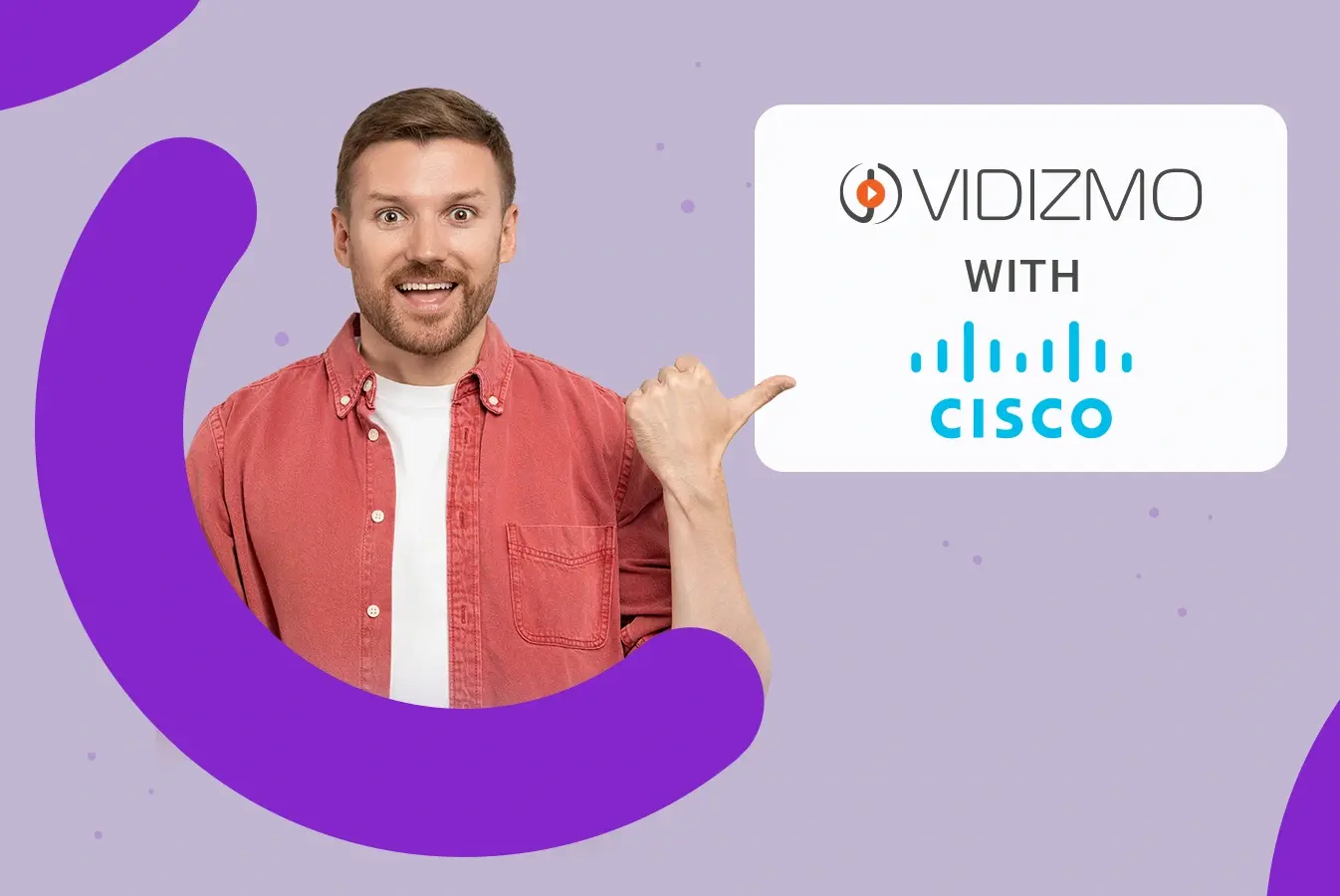How a Content Delivery Network Helps Deliver Smooth Video Streaming
by Rafay Muneer on April 06,2022

No one likes sitting down to stream a video and having it buffer endlessly. While these start-and-stop annoyances are bad enough for personal viewing, they're even worse for corporate on-demand and live video streaming. Imagine streaming an important meeting or conference only for it to keep stopping every so often.
Luckily, there is a solution to these problems—a content delivery network. CDNs have been historically used by websites to deliver content to geographically dispersed users.
In fact, out of the top million websites, 43.8% of them use some form of Content Delivery Network (CDN) to serve web content and images, among other things.
And it's the same for videos. Want to seamlessly share content with the maximum number of people as an organization? That's where the concept of video CDN comes in. But what is content delivery, and how does a CDN work for video streaming?
To answer these questions and more, this blog will cover all things related to CDNs, including the value of video CDNs and their benefits.
What is a Content Delivery Network?
A Content Delivery Network (CDN), also referred to as a Content Distribution Network, is a network of servers placed in different geographical regions. These servers copy over content such as images, videos, audio files, and more and store a cached version of this content.
When users try to access any content, the CDN helps them serve the file from the server closest to their location rather than getting it from its original server. This helps users access files faster, reduces load on servers, and distributes content globally.
But more than that, it's also cost-effective. Businesses can't afford the cost of deploying individual servers worldwide due to the increasing demand for data. As a result, they usually rely on CDN providers, which have their servers deployed globally, for content delivery.
What is an eCDN?
An enterprise content delivery network (eCDN) is a specialized form of CDN meant solely for enterprise traffic. While a CDN is public-facing, eCDNs route traffic through a specifically allocated enterprise network along with edge caching capabilities to relieve network bottlenecks in broadcasting video content to locations like corporate offices.
What is Content Delivery?
Content delivery refers to the process of distributing content to an audience. This can refer to both print and digital media. However, in our increasingly digital world, this is more commonly used to talk about the digital distribution of content.
How Does a Content Delivery Network Work for Video Streaming?

For video streaming, a content delivery network caches video content from the origin server and then streams it from the nearest edge server to the user.
The distance between the server and the user adds potential latency to the Internet connection. The speed of content reaching the viewer's device depends on the Internet speed and the distance from the origin server.
Content delivery networks resolve this problem by using edge servers, which either serve cached content or request that data from the next available edge server. This makes the trip between servers short and distributes the overall load.
As a result, CDN provides a high-quality and seamless video experience. Several video streaming platforms use CDNs to make the delivery of on demand video and live video streaming faster by avoiding slow loading speeds and buffering delays.
Benefits of A Content Delivery Network for Video Streaming
A content delivery network poses several advantages to traditional video hosting and delivery methods for streaming video content. These include:
They Help Reduce Latency
Content delivery networks help shorten the distance that data packets travel by making sure there is more than one server available to address a user request.
For instance, if you stream videos from the USA to viewers in Japan, they will be cached and stored in edge servers in Japan. When your Japanese viewers watch a video, it will be streamed from the edge server in Japan rather than the origin server in the USA.
This way, the trip that data takes becomes much shorter, and any delay or interruptions a user faces is minimized.
They Balance the Network Load
When multiple users around the world request content from a single server, it can put a lot of strain on it. With enough load, the server can end up struggling to keep up with different requests.
That's where CDNs come to the rescue. Instead of overwhelming the origin server, a group of servers can handle streaming video to hundreds of viewers far better than just a single server. This creates a high availability environment where congestion and server failures don't disrupt anyone's experience.
They Can Cut Down Buffering
Congested bandwidth during live video streaming between multiple users means a lot of buffering. This prevents viewers from getting their desired playback experience. The flexibility of using a CDN means that it can support streams to provide a smooth, consistent experience even during an unexpected number of viewers.
They Offer Scalability
The distributed nature of using CDNs for delivering on-demand and live video streaming means that the network will be flexible enough to adapt to any changes. You can easily increase or decrease your CDN resources based on traffic fluctuations without needing to upgrade your origin server's capacity. This allows you to handle spikes in traffic without compromising performance.
They're Cost-Effective
Dispersing your own global content infrastructure is a massive undertaking that involves a hefty monetary and time investment. Not every organization can afford to do that. Instead, broadcasters can opt to use CDN services to offload the burden of infrastructure management.
CDN providers offer a cost-effective solution with a vast network of edge servers strategically placed around the world. They can eliminate the need for expensive hardware and global network setup, only for the resources they use.
They Provide Enhanced Security
On top of delivering a smooth streaming experience, CDNs also ensure secure content delivery. Streaming behind a CDN helps prevent threats such as a DDoS attack. The nature of CDNs means that a flood of repeated requests in an attempt to overload and breach it simply won't work.
CDNs also make it more difficult for attackers to launch a successful 'man in the middle' attack. An attacker would need to compromise a significant portion of the CDN's edge servers to effectively intercept traffic in a meaningful way.
What to Look for in a Content Delivery Network for Video Streaming?
Once you've figured out your need for a content delivery network, the next step is to understand how to pick one. There are several factors to consider before picking dedicated CDNs for video streaming. First and foremost, you will have to make sure that it has a massive, dependable network with servers wherever you're attempting to reach.
Then, some other factors may come into play, such as your data transfer capacity, support for live streaming, support for Adaptive Bitrate (ABR), your data storage site, required geographical coverage, and more.
While settling on what you're searching for, consider a video management platform that utilizes CDN providers for on demand video content delivery and live video streaming. These online video streaming platforms will often deliver all the functionality you need to stream videos on a global scale.
VIDIZMO EnterpriseTube – All-in-One Video Content Delivery Solution
VIDIZMO EnterpriseTube, a Gartner-recognized enterprise video content management system, provides businesses with a professional platform with all the capabilities for enhanced video delivery.
Instead of having to get video content management and delivery solutions separately, organizations can enjoy the benefits of a CDN and a video platform all at once with EnterpriseTube.
Content delivery is just one aspect of video streaming and management. There is much more depth in this world of streaming. A video content management system such as VIDIZMO EnterpriseTube caters to help cater to end-to-end video needs.

Here is just some of what VIDIZMO has to offer:
- A customizable corporate video portal to stream live and on-demand videos to your external and internal audiences.
- Live video streaming through modern protocols like HLS so that there are no bandwidth issues and the video is played seamlessly on almost every device and operating system.
- Video transcoding for all your videos to ensure optimized playback. With an enterprise content delivery network (eCDN), stream videos to a large audience on your corporate network by caching videos internally.
- Scalable live streaming enables you to stream regardless of the users. Scalable to an unlimited number of users while streaming on any device.
- Automatic multilingual transcription and translation of spoken words in video and audio.
- Secure video sharing through temporary tokenized URLs that expire based on time and view limits.
- You can also limit videos by segregating your content into users and groups and by using categories with secure access control.
Wrapping Up
A platform with a combined content delivery network and video hosting capabilities is the one to opt for if you want a hassle-free experience. After all, why should online video delivery be this complex?
VIDIZMO EnterpriseTube ensures you get the highest quality and no service disruption by utilizing CDNs to deliver smooth, bufferless streaming.
Ready to go live? Try VIDIZMO EnterpriseTube for 7 days free, or contact us to learn more.
People also ask
What is a content delivery network?
A content delivery network is a group of geographically distributed that caches content from an origin server to serve the nearest user that requests that content.
How can I start live streaming?
To start live streaming, you'll need recording equipment, a stable internet connection, and a streaming platform. Simply set up your equipment, choose your platform, and start broadcasting.
What is CDN live streaming?
CDN (Content Delivery Network) live streaming is when a network of servers is distributed globally and delivers live video content to viewers. This helps reduce buffering and improves the viewing experience by serving content from the server closest to the viewer.
What is CDN used for?
CDNs are used to distribute content, like videos, images, and webpages, to users more efficiently. They store cached copies of content on servers located around the world, allowing faster and more secure content delivery to users regardless of their geographic location.
Is it safe to use CDN?
CDNs are generally considered safe to use. They are designed to improve performance and security for secure content delivery. However, the scope of security will depend on the individual CDN provider.
Jump to
You May Also Like
These Related Stories

VIDIZMO integrates with Cisco TelePresence

Vbrick Alternatives: Exploring VIDIZMO EnterpriseTube

No Comments Yet
Let us know what you think